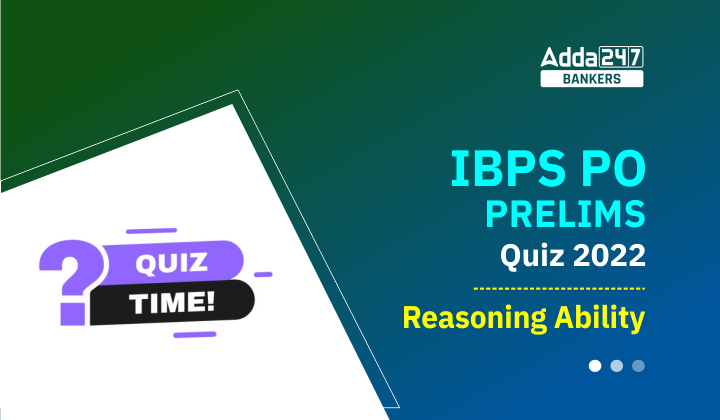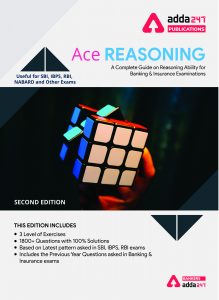Directions (1-5): Study the following information carefully and answer the given questions.
Eight students have seated around a circular table in which some are facing towards the centre and some are facing outside the centre. E sits third to the right of D. Only two persons sit between G and B, both are facing same direction. A sits third to the right of the one who sits second to the left of G. F is neither immediate neighbour of G nor B. C sits third to the right of F who sits opposite to H. G is facing same direction as D but opposite to C and A. E sits second to the right of H who is facing same direction as F. B and D faces each other. E faces towards the center.
Q1. Who among the following sits third to the right of A?
(a) E
(b) F
(c) D
(d) G
(e) None of these
Q2. Who among the following sits opposite to C?
(a) B
(b) E
(c) H
(d) A
(e) None of these
Q3. How many persons sits between D and H, when counting left of D?
(a) Four
(b) Three
(c) Two
(d) One
(e) None
Q4. What is the position of B with respect to F?
(a) Third to the left
(b) Immediate right
(c) Second to the right
(d) Immediate Left
(e) None of these
Q5. How many persons facing inside?
(a) One
(b) Four
(c) Three
(d) Two
(e) None of these
Directions (6-10): In these questions, relationship between different elements is shown in the statements. The statements are followed by conclusions. Study the conclusions based on the given statements and select the appropriate answer. Give answer-
Q6. Statements: S ≤ L ≤ I = P ≥ E > R; L > Q
Conclusions: I. P > Q II. Q > R
(a) If only conclusion II is true
(b) If only conclusion I is true
(c) If both conclusions I and II are true.
(d) If either conclusion I or II is true
(e) If neither conclusion I nor II is true.
Q7. Statements: G > R ≥ E = A ≤ T ≤ S; D ≤ A ≤ J
Conclusions: I. T > J II. J = S
(a) If only conclusion II is true
(b) If only conclusion I is true
(c) If both conclusions I and II are true.
(d) If either conclusion I or II is true
(e) If neither conclusion I nor II is true.
Q8. Statements: A ≥ B > C ≤ D, D ≤ E < F
Conclusions: I. A ≥ E II. E < A
(a) If only conclusion II is true
(b) If only conclusion I is true
(c) If both conclusions I and II are true.
(d) If either conclusion I or II is true
(e) If neither conclusion I nor II is true.
Q9. Statements: G > R ≥ E = A ≤ S; D ≤ A ≤ J
Conclusions: I. J > G II. G ≥ J
(a) If only conclusion II is true
(b) If only conclusion I is true
(c) If both conclusions I and II are true.
(d) If either conclusion I or II is true
(e) If neither conclusion I nor II is true.
Q10. Statements: S ≤ L ≤ I = P ≥ E > R; L > Q
Conclusions: I. I ≥ R II. R < I
(a) If only conclusion II is true
(b) If only conclusion I is true
(c) If both conclusions I and II are true.
(d) If either conclusion I or II is true
(e) If neither conclusion I nor II is true.
Directions (11-15): Study the following information to answer the given questions:
Eleven persons A, B, C, D, E, F, G, H, I, J, K are sitting in such a way that some are facing North and some of them are facing south. Not more than two consecutive persons face same direction. No two persons sit adjacent to each other according to the English alphabet (i.e., B does not sit adjacent to A and C and so on).
D sits 2nd from one of the ends and faces south. Four persons sit between D and J. Persons at both the ends face same direction as C who is sitting exactly in the middle of the row. Number of the persons sitting to the right of C is one more than those sitting right of J. Both C and J face opposite direction. Two persons sit between J and K who faces same direction as C. E and H are neighbors of each other. Both G and I are immediate right to each other, one of them is next to C. Four persons sit between E and G. Immediate neighbors of D face same direction. A is not neighbor of D. Not more than four persons face south.
Q11. How many persons in the above arrangement are facing north?
(a) 7
(b) 6
(c) 5
(d) 8
(e) None of these
Q12. Who among the following represents the pair of persons who are immediate neighbor of B?
(a) A-F
(b) G-D
(c) H-D
(d) J-C
(e) None of these
Q13. Four of the following five forms a group, who does not belong to that group?
(a) C
(b) A
(c) B
(d) G
(e) H
Q14. Which of the following pair represents the persons sitting at the ends?
(a) D-E
(b) A-B
(c) F-A
(d) G-B
(e) A-C
Q15. Who among the following sits 5th right to H?
(a) E
(b) B
(c) F
(d) G
(e) None of these
Solutions
Solutions (1-5):
Sol.

S1. Ans. (d)
S2. Ans. (d)
S3. Ans. (c)
S4. Ans. (a)
S5. Ans. (b)
S6. Ans. (b)
Sol. I. P > Q (True) II. Q > R (false)
S7. Ans. (e)
Sol. I. T > J (false) II. J = S (false)
S8. Ans. (e)
Sol. I. A ≥ E (false) II. E < A (false)
S9. Ans. (d)
Sol. I. J > G (false) II. G ≥ J (false)
S10. Ans. (a)
Sol. I. I ≥ R (false) II. R < I (True)
Solutions (11-15):
Sol. 
S11. Ans. (a)
S12. Ans. (b)
S13. Ans. (d)
S14. Ans. (c)
S15. Ans. (b)





 GA Capsule for SBI Clerk Mains 2025, Dow...
GA Capsule for SBI Clerk Mains 2025, Dow...
 The Hindu Review October 2022: Download ...
The Hindu Review October 2022: Download ...
 IBPS PO Apply Online 2025, Online Applic...
IBPS PO Apply Online 2025, Online Applic...


